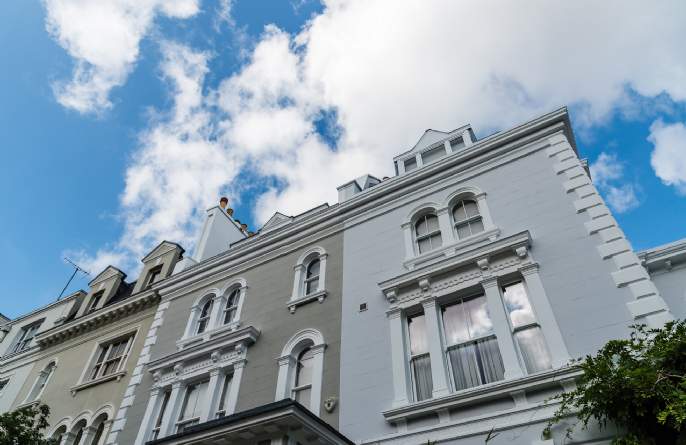Jess Tomlinson and Lucian Cook answer your questions on the prime rental market. Filmed at Park Modern, Hyde Park.
Over the course of 2021, 2022 and 2023 rental values of prime residential property in London rose by an eye-watering average of 23.1%. To put this in context, it was the strongest three-year period of growth in rents for a quarter of a century.
And similarly outside of the capital, in the most affluent urban neighbourhoods and rural idylls, rents of prime properties increased by more than 20% over this period.
But over the last six months, we have seen apronounced change in market conditions, with annual rental growth slowing and an increasingly wide divergence in landlord and tenant rent expectations.
Then...
For the best part of the past three years, rents were propelled by a powerful combination of an acute imbalance between demand & supply and high levels of underlying earnings growth. At times the market was frenetic, with even the most experienced agents claiming they hadn’t seen anything like it in their careers.
At some point, the imbalance was going to ease. However, it was always unlikely to completely unwind given both the financial pressures faced by mortgaged landlords and the prospect that landlord and tenant reform will limit stock brought to the rental market.
And as we are beginning to see, wage growth would slowly bring rental affordability more sharply into focus, much as in the wider mainstream market.

…AND NOW
So as we entered 2024, we sensed the return to a more seasonal rental market; one where rents rise in the first half of the year but typically struggle to maintain that momentum in the third and fourth quarters.
Our prime indices tell us that rents of prime properties did indeed rise in the first three months of the year. But in London the growth, of 0.3%, was less than a third of that seen a year earlier. In the regional markets, while higher (at 0.9%), it was also much closer to what might loosely be considered normal.
As a consequence, annual rental growth of prime London properties has fallen to 3.2%, while beyond the capital it now stands at 4.0%, someway below the double-digit annual rental growth making the headlines at times in the recent past.
Q. What's the story with landlords selling up?
Firstly it is worth saying we have not seen the exodus of private investors that some envisaged when interest rates started to rise and Government moved through the gears, shifting from talking about rental reform, to issuing a White Paper, to laying the Renters (Reform) Bill before Parliament.
Yes, we have seen some landlords rationalise their property holdings and in some cases head for exit, but the sale of properties bearing Capital Gains Tax has remained remarkably consistent, with no discernible upward trend. And while the pool of outstanding buy-to-let mortgages has eased back to below two million for the first time since October 2020, the falls are marginal – if anything suggesting a rebalancing of the sector towards fewer, larger, wealthier landlords.
Bringing Capital Gains Tax rates back in line with other assets from April this year could encourage a few more landlords to cash in their chips, especially if they believe there is a risk tax rates will rise under a change in government.
But at the same time, the prospect of falling mortgage rates will ease some of the financial burden on landlords, especially given improved yields will support continued investment in the sector.
On that basis, the prospect of a further surge in rental values, on the back of a pronounced shortage of properties available to rent, is limited. However, significant downward pressure on rents is equally unlikely, as there are few signs that investor landlords will pile back into the market.
So it would seem a sensible time for landlords to benchmark their existing rents against open market levels to capitalise on the recent burst of rental growth, without fear of missing out on what might be around the corner.
.jpg)
Q. Where have we got to with the abolition of the Assured Shorthold Tenancy Agreement?
The enaction of the Renters (Reform) Bill would see the end of the Assured Shorthold Tenancy Agreement, removing the automatic right for landlords to bring such a tenancy to an end on the service of two months’ notice.
While therefore giving the majority of tenants substantially more security, at the same time it would give landlords to right to recover possession of the property where they had a genuine intention to sell it or required it for their own occupation or that of a close family member. And, as drafted, rents would be reviewed to open market levels once a year.
However, the progress of the Bill has been somewhat tortuous. Having had its first reading as long ago as May last year, the Bill was still at report stage in the House of Commons at the time of writing. However, with the Government offering some concessions to landlords its third and final reading in the House of Commons seems likely in the near term, (before it is passed through the House of Lords for further scrutiny).
Those concessions would mean tenants would only be able to serve two months’ notice to vacate a property after four months in occupation (thereby creating a six-month minimum term) and delay the abolition of the Assured Shorthold Tenancy until the judicial machinery is in place to cope with any increased court workload.
Still, it will represent the biggest change in landlord and tenant legislation in over 30 years.

To read more of our Residential Research please visit our Residential Hub
Read the articles within Report: Prime UK Residential – spring/summer 2024 below
.jpg)
.jpg)
.jpg)
.jpg)
(1).jpg)